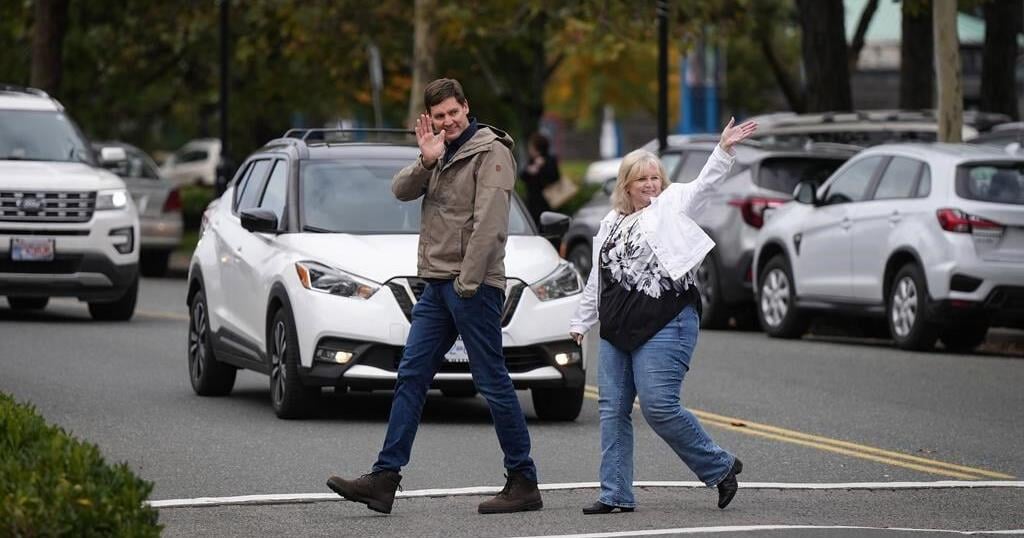LANGLEY, B.C. – Violence should have no place in British Columbia politics, said New Democrat Leader David Eby as police investigated a bomb threat at a party campaign office on Vancouver Island.
Eby said Saturday an NDP campaign office in Campbell River was temporarily evacuated Friday after receiving a bomb threat.
Eby, who was campaigning Friday in the Vancouver Island city, said he was not in the NDP office when the threat was received.
He said he is grateful for the courage of the office staff who were told to evacuate by the RCMP.
“Violence has absolutely no place in our politics,” said Eby at a campaign stop Saturday in Langley. “We see in other parts of the world where people have to endure violence as part of the democratic process. We don’t want that in British Columbia. It’s absolutely shameful.”
He said he did not know what intent was behind the threat, but supported police investigation efforts.
“And I hope they get to the bottom of it and they arrest this person and charge them,” he said.
The RCMP were not immediately available for comment.
“A campaign manager for the B.C. NDP received a bomb threat while working at the Campbell River campaign office yesterday (Friday) afternoon,” B.C. NDP Provincial Director Heather Stoutenburg confirmed in a statement. “Police were immediately alerted and our staff was asked to temporarily vacate that campaign office.”
Earlier on Saturday, B.C. Conservative Leader John Rustad said he will release his party’s costed election platform on Tuesday, five days before the Oct. 19 voting day.
“The plan right now is to be able to announce that on Tuesday,” he said. “We will detail how that will be paid for.”
Rustad said the platform will outline the cost of the B.C. Conservative spending promises, including massive highway, bridge and transit infrastructure projects.
He said, if elected, voters can expect several years of deficit spending to continue, before the province returns to balanced budgets by the end of a second B.C. Conservative term.
“It’s not realistic to try and do that in one term,” Rustad said. “It would be unfair to both the services and the people in B.C.”
B.C.’s current budget is forecast to see a deficit of more that $9 billion, with Eby pledging reduced deficits in the coming years with a return to balanced books at an unspecified year.
Eby has been critical of the decision by Rustad’s B.C. Conservatives to hold off on presenting their complete campaign platform until late in the campaign.
He said voters were denied the opportunity to see Rustad defend his party’s campaign promises at last week’s televised leader’s debate because the party platform was not ready.
“We had an all candidates debate to discuss the issues which the Green Party presented a fully costed platform. The NDP presented a fully costed platform, and John Rustad presented nothing,” said Eby. “He had his chance to explain his platform and what we’ve seen as proposals for cuts, conspiracy theories, division between communities.”
“I think British Columbians have seen enough. They know who’s on their side and who isn’t.”
Rustad was in the Metro Vancouver city of Surrey Saturday where he visited a food bank, pledging, if elected, to implement a dedicated yet unspecified government fund to ensure help is available for rising numbers of people in need.
“The need in the community is growing,” he said. “Government needs to be able to step up to the plate and be there for people in this province.”
Eby pledged to complete major transportation projects underway across the Metro Vancouver area, including SkyTrain expansions to the University of British Columbia, from Surrey to Langley and Highway 1 improvements from Langley to Chilliwack.
Green Leader Sonia Furstenau was campaigning in Victoria while federal Green Leader Elizabeth May was in Creston campaigning with B.C. Kootenay Central candidate Nicole Charlwood.
— By Dirk Meissner in Victoria, with files from Brieanna Charlebois in Vancouver
This report by The Canadian Press was first published Oct. 12, 2024.
